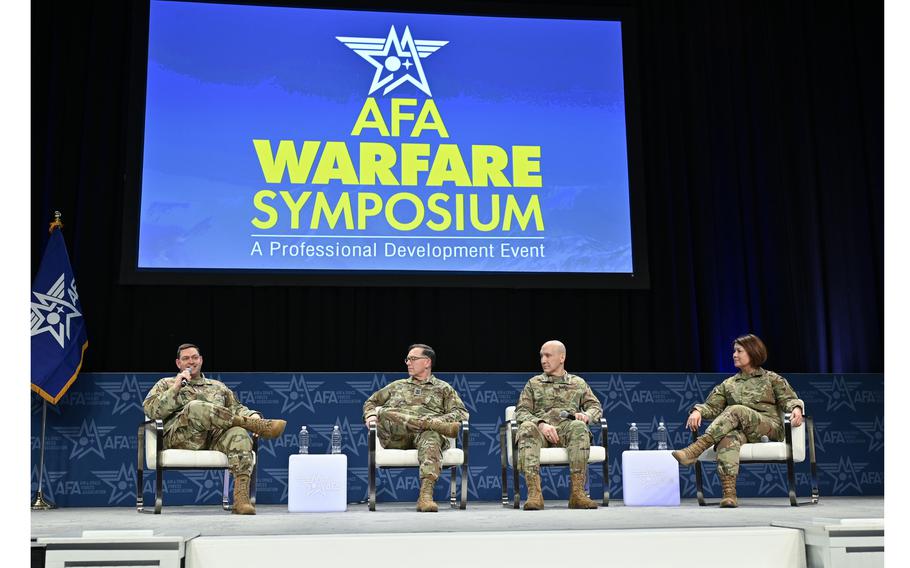
Chief of Space Operations Gen. Chance Saltzman, left, Chief Master Sgt. of the Space Force Roger Towberman, Air Force Vice Chief of Staff Gen. David Allvin and Chief Master Sgt. of the Air Force JoAnne Bass speak during the panel discussion “Warfighting from the Homefront: Senior Leaders Perspective” at the Air and Space Forces Association 2023 Warfare Symposium in Aurora, Colo., March 6, 2023. (Eric Dietrich/U.S. Air Force)
If China or Russia blew up U.S. satellites, it could cripple critical infrastructure, such as GPS navigation and the debris could litter valuable orbits, perhaps leaving them unusable.
To deter such a conflict, the U.S. Space Force expects to focus on expanding the number of satellites it relies on and ensure they are disaggregated and diversified, making an attack in space too “escalatory and self-defeating,” said Gen. Bradley Chance Saltzman, chief of space operations.
“We complicate targeting; we get resiliency,’” he explained.
Saltzman was one of several high-ranking military officers to underscore the importance of ramping up the U.S. investment in space during the Air and Space Forces Association Warfare Symposium in Aurora this week.
In the past, U.S. satellites were like supertankers at sea built for efficiency, said Space Command Deputy Commander Gen. John Shaw. Space Command was reestablished during 2019 in Colorado Springs. In addition, the city is home to Peterson and Schriever Space Force Bases.
Now, the U.S. needs commoditized satellites that can have sustained maneuverability, he said.
“We have to completely rethink how we do our space architectures,” he said.
The Space Development Agency is already working on expanding a constellation of satellites known as the Proliferated Warfighter Space Architecture, with an upcoming launch of 20 satellites for communications and data and eight in missile warning and tracking, according to Breaking Defense.
“I am very excited about seeing a launch this year,” Saltzman said.
Upgraded U.S. satellites are critical as China aggressively pursues a mix of new weapons, he said. For example, the Chinese successfully used a robotic arm on a satellite to move another one last year.
In the race to deter conflict, Air and Space Force leaders emphasized that skilled servicemembers are key.
“Our guardian talent is our most important operational advantage,” Saltzman said.
Unlike other services, the Space Force has not seen problems recruiting. For example, Air Force Secretary Frank Kendall predicted a 10% shortfall in recruitment this year on Tuesday during the symposium.
In contrast, the Space Force selects 500 recruits a year and has turned away tens of thousands of interested applicants, said Chief Master Sgt. Roger Towberman. With about 8,000 guardians total, the force is interested in quality personnel and retention, he said.
The military will be doing a required review of compensation across the board this year, and he expects the pay chart will be examined through a modern lens that may reward highly technical positions, that may not be defined by college degrees, he said.
The force is also exploring new assessment tools for physical fitness that will allow a guardian’s health to be assessed on a regular basis, instead of the traditional annual test, Towberman and Saltzman said.
Space Force training could also get a boost in the coming 2024 budget, with a focus on virtual simulation, Saltzman said.
“We need depth of experience, depth of technical excellence,” Towberman said.
(c)2023 The Gazette (Colorado Springs, Colo.)
Visit at www.gazette.com
Distributed by Tribune Content Agency, LLC.